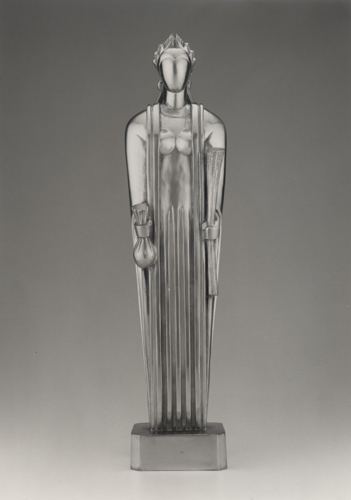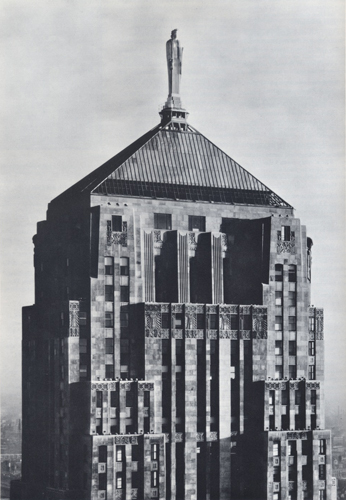 |
| Sky Harbor Club House, circa 1929 with Gray Goose Air Lines tri-motor sightseeing plane photo courtesy Northbrook Historical Society |
Some of the earliest airfields in Chicago, like short-lived Cicero Field (1911-1916) catered mainly to private aviation enthusiasts. Wooden sheds were built to house airplanes, mechanics, and amenities for pilots and spectators. But by the mid-1920s, more commercial airfields were established and catered to the needs of airmail carriers and passenger lines. Municipal Field (later renamed Midway Airport) in Chicago and Curtiss Field (later renamed Curtiss-Wright) in Glenview sported terminal buildings designed in "modernistic styles" with a spare, almost industrial aesthetic. The clean lines, flat roofs, smooth surfaces, and ribbon windows of Paul Gerhardt's Municipal Airport terminal are reflective of this more modern aesthetic:
 |
| Chicago Municipal Airport, circa 1931 (now demolished) designed by Paul Gerhardt, Jr., City of Chicago Architect. |
Interestingly, the early designs for Sky Harbor were fairly traditional. The Colonial-style club house looks like it would be at home on the edge of a golf course. The designs for the hangar were more modern with stepped-back, "Vertical Style" towers flanking an arched opening:
 |
| Early designs for Sky Harbor Airport as published in Aviation: The Next Great Industry United Aviation Corporation (n.d., but probably 1927 or 1928) |
"...a picturesque and attractive structure that is both the latest thing in modernistic architecture and also reminiscent of ancient Aztec buildings. It symbolizes air flight, as it rises higher and higher, diminishing in bulk as an airplane seems to do to the earthbound mortal gazing after a skybound plane."
 |
| Sky Harbor club house (under construction), 1929 designed by Alfred P. Allen + Maurice Webster photo courtesy Library of Congress |
Designed by Alfred P. Allen and Maurice Webster "associated architects," the club house was an unusual stylistic and programmatic synthesis. In aerial photos, its centralized, tower-like design competes with neighboring farm silos to mark its place within the flat agricultural landscape. Its stepped-platform design is vaguely temple-like and culminated in a two-story lantern that must have been visible for miles at night when lit from within. The first floor contained a waiting room, public facilities, and airport offices. The second floor housed a restaurant and nightclub (operated by the owners of Perushka's, a downtown Chicago hotspot). The third floor contained a lounge and rooms for overnight guests. Wrapping the exterior of the building was a series of terraces which accommodated aviation spectators -- according to the same Chicago Tribune article from 1929, "Night flying, with its searchlights and flares, is an exciting spectacle."
 |
| Sky Harbor Club House as drawn by Alfred P. Allen + Maurice Webster, Associate Architects and published in American Architect, July 1929 |
The hangar at Sky Harbor was a completely different architectural expression, perhaps designed by a different architectural firm. It's elegant, low arch anticipates the Streamline Moderne architecture of the 1930s.
 |
Sky Harbor aircraft hangar (under construction), 1929 architect unknown photo courtesy Library of Congress |
 |
Aerial view of Sky Harbor airport, 1929 Northbrook, Illinois photo courtesy Library of Congress |
Changing owners several times, Sky Harbor, continued to operate as a small, regional airport until 1973. Although the runway is long gone and built over by new development, parts of the hangar miraculously survive today. You can view some good photos (both current and vintage) of the hangar on Paul Freeman's website "Abandoned & Little-Known Airfields."
http://www.airfields-freeman.com/IL/Airfields_IL_Chicago_N.htm
Special thanks to Judy Hughes of the Northbrook Historical Society.
Sources include:
Aviation: The Next Great Industry, promotional booklet published by United Aviation Corporation, n.d., circa 1928.
"'All Airplanes Lead to Chicago': Airport Planning and Design in a Midwest Metropolis" by David Brodherson and published in Chicago Architecture and Design, 1923-1993, pages 75-97.
"Night Flying at Sky Harbor" and "Ideal Landing Field", Chicago Tribune, 7 July 1929.













